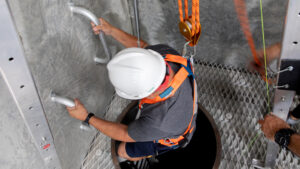A government authority can find itself being all different types of PCBU at once. Here is an overview of how safety risks can be addressed by local and shire councils as well as infrastructure and utility providers.
Government authorities come in a variety of shapes and sizes. They can range from local and shire councils through to infrastructure and utility providers. The size of these authorities can also vary greatly, depending on their location and the scope of their responsibility.
In terms of workplace safety, government authorities can fill just about every role from developer or builder, through to employer, facility manager and down to being responsible for individual workers out on site. They are also required to manage a range of contractors and third-party service providers as well.
Also being thrown into the mix is the simple fact that authorities like this undertake a variety of different types of work, many of which are outside the typical scope of what is seen in the building, manufacturing and maintenance sectors.
As a result, government authorities are faced with needing to identify and provide mitigation against risks that might not be commonly encountered in the wider world.
Below are some tips for government authorities in how they can manage their site risks, team risks and individual worker risks no matter the type of work being undertaken.
Managing site risks
When it comes to management of site risks, government authorities should consider themselves as fulfilling the role of both builder/construction supervisor and facility manager, depending on the exact situation they are facing.
Local government bodies, like Councils, are often responsible for management of council owned facilities like community centres, pools, council chambers and libraries.
When considering the risks associated with undertaking work at heights on these facilities, four simple questions should be asked:
- Do you know your risk areas?
- Are your systems being maintained correctly?
- What is your site induction process?
- Do you know what to look for?
When completing construction or building work, government authorities should be asking themselves a couple of important questions regularly as part of that work:
- Have you thought about how the work will be completed?
- Does your team have the equipment they need?
- Do your team know how to use the equipment?
- Have you developed a rescue plan?
Making sure that site risks are identified and mitigated is an important part of making sure that workers and contractors are provided with a safe place of work. In their role as a facility manager or building/construction manager, government authorities need to ensure this is being done on their sites.
Managing team risks
As either an employer, or someone who engages subcontractors, government authorities have the responsibility to manage the risks associated with having teams of workers access their sites.
To that end, they need to ensure that their own teams, or those teams coming onto site, have the skills and knowledge required to safely access work areas and complete their tasks.
There should also be a comprehensive set of procedures and manuals available to assist teams in understanding how to use any safe access and fall protection systems present on the site. A comprehensive induction and sign-on process should also be in place to check that team members have the skills and qualifications required to safely complete the work.
Rescue plans should also be developed and checked. Although no one ever plans for an accident to occur while working at heights, the risk of one occurring is never zero and being able to respond quickly and effectively to one can save a life. This is especially true with falls from height, as the risks of injury from suspension trauma can be realised in less than 10 minutes.
Managing risks for workers
Workers are, ultimately, the people who face the risks of an injury in a workplace accident. It is critical that every worker be equipped with the skills and equipment they need to safely go about their tasks.
Along with this, workers should be able to work in an environment around there where they can advocate for their own safety. It is important that safety issues being raised by workers are taken seriously and addressed by their employer and the site or facility manager.
In terms of skills, every worker should really have completed three basic levels of training prior to entering any site.
First, there is a general safety induction. Second is task specific training (for example, height safety or confined space safety). Third is a site-specific induction, that covers off the exact risks that exist in the particular environment they are going to be working.
Workers should also be checking that access procedures and safety system use manuals provided by worksites are adequate and match the conditions found on site. They should also make sure that safe work procedures provided by their employer can be used in conjunction with the site instructions. Any discrepancies or uncertainty should be dealt with prior to starting work.
Get expert help before a concern becomes an accident
The team at Height Safety Engineers work with a range of local government authorities, local councils, government departments and utility providers every day. They have the experience and knowledge to address all manner of height safety and confined space access risks.
Height Safety Engineers are your partners in protecting people. Call our experts today on 1300 884 978 or email enquiries@heightsafety.net to start your safety journey.





